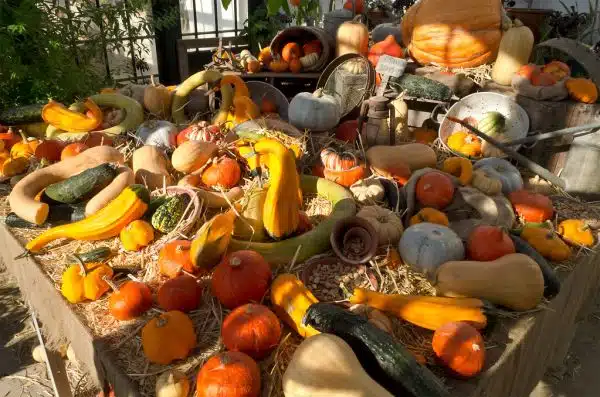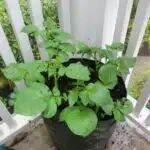Ornamental gourds are a type of squash that have been cultivated for decorative purposes for centuries. They come in a variety of shapes, sizes, and colors, making them a popular choice for fall decorations such as table centerpieces and wreaths. Growing ornamental gourds is an enjoyable hobby that can be enjoyed by both seasoned gardeners and beginners alike.
To grow ornamental gourds successfully, it is important to understand their growing requirements. These plants thrive in warm temperatures and need plenty of sunlight to grow properly. Furthermore, they require well-draining soil that is rich in organic matter to support their growth. With the right care and attention, ornamental gourds can provide a beautiful addition to any garden or home decor project. In this article, we will explore the steps involved in growing ornamental gourds successfully from seed to harvest, including planting tips, fertilization strategies, pest management techniques, and harvesting advice.
Choosing The Right Varieties Of Ornamental Gourds
Ornamental gourds are an excellent way to add color and interest to your garden. These unique plants come in a variety of shapes, sizes, and colors, making them a great choice for anyone looking to add some visual appeal to their outdoor space. When choosing the right varieties of ornamental gourds, there are a few things to consider.
One of the most important factors is the color options available. Ornamental gourds come in a range of colors, including green, yellow, white, orange, and red. Some varieties even feature stripes or speckles. When selecting your gourd seeds or seedlings, think about what colors will complement your existing garden or home décor.
Another important consideration is the best time to plant ornamental gourds. These plants thrive in warm weather and require plenty of sunlight and water. In general, it’s best to plant ornamental gourd seeds or seedlings after the last frost date in your area. This will give them plenty of time to grow before cooler temperatures arrive in the fall.
Understanding ornamental gourd planting zones is also crucial for success with these plants. Different varieties have different requirements when it comes to temperature and growing conditions. By choosing varieties that are well-suited for your region, you can ensure that your ornamental gourds will thrive and produce beautiful fruits throughout the growing season.
Understanding Ornamental Gourd Planting Zones
Ornamental gourds come in a wide variety of shapes, sizes, and colors. Each type of gourd brings something unique to the table, making it important to choose the right varieties for your garden. However, before you start planting, it is important to understand ornamental gourd planting zones.
Climate considerations are an essential factor when choosing where to plant your ornamental gourds. Understanding the hardiness ratings of each type can help ensure that they will thrive in your area. For example, if you live in a colder climate with shorter growing seasons, it may be best to choose gourds with higher hardiness ratings.
To help determine which ornamental gourds are suitable for your area, refer to the USDA Plant Hardiness Zone Map. This map divides North America into 11 different zones based on average annual minimum temperatures. The map can help you identify which zone you live in and what types of plants will grow well there. Once you have determined your zone, you can select ornamental gourds that are known to thrive in that particular zone.
Understanding ornamental gourd planting zones is crucial in ensuring that your gourds grow successfully. By selecting varieties with appropriate hardiness ratings and taking into account climate considerations, you can create a thriving garden filled with beautiful and unique ornamental gourds. In the next section, we will discuss how to select the optimal growing site for your gourds.
Selecting The Optimal Growing Site For Your Gourds
- When selecting a location to grow ornamental gourds, it is important to consider the amount of sunlight the area receives, as gourds require at least 6 hours of direct sunlight each day.
- The soil should be fertile and well-draining, so it is advisable to mix in organic matter such as compost or manure to the soil prior to planting.
- Exposure to wind should also be taken into account, as this can cause the gourds to become misshapen and can even cause the vines to break.
- For optimal growth, gourds should be planted in a location that is sheltered from strong winds.
- The ideal soil pH for growing gourds is between 6.0 and 6.5, as this range is most conducive to optimal nutrient uptake.
- To ensure the best possible growth and yields, it is important to select a location that provides the proper soil type, sun exposure and protection from wind.
Choosing A Location
Selecting the optimal location for growing ornamental gourds is crucial to ensure a bountiful harvest. The ideal soil conditions for gourd cultivation are well-drained, nutrient-rich, and slightly acidic. Gourds benefit from full sun exposure, so it is best to choose a location with direct sunlight for at least six hours daily. For water requirements, gourds need regular watering without being overwatered or underwatered. It is important to avoid planting in low-lying areas or where water tends to accumulate.
When selecting the location for your ornamental gourds, keep in mind that these plants require ample space to grow and spread out. Make sure you have plenty of room available for the vines to climb and expand without crowding nearby plants. Additionally, it is recommended to avoid planting ornamental gourd varieties near edible crops as they are susceptible to cross-pollination.
While growing ornamental gourds, there are several pests and diseases that you should watch out for such as aphids, squash bugs, powdery mildew, and vine borers. To prevent these issues from occurring, it is best to avoid planting in areas where these pests are commonly found. By choosing an optimal location with ideal soil moisture levels and proper sun exposure while keeping an eye out for potential pests and diseases, you can ensure a successful harvest of beautiful ornamental gourds.
Soil Type
Selecting the optimal growing site for your gourds is a critical factor in ensuring a successful harvest. One of the essential aspects to consider when choosing the right location is soil type. The best soil for cultivating ornamental gourds is well-drained, nutrient-rich, and slightly acidic. The ideal pH level for gourd cultivation ranges from 6.0 to 6.5.
To achieve the ideal soil conditions for growing ornamental gourds, it is recommended to use the best fertilizers and soil amendments available in the market. Organic materials like compost, manure, or bone meal are excellent choices as they provide essential nutrients needed by the plants throughout their growth cycle. These organic matter also helps improve soil structure and water-holding capacity.
Aside from using fertilizers and soil amendments, it is important to test your soil regularly to ensure that it remains within the desired pH range. If necessary, you can adjust your soil’s pH level by adding lime or sulfur depending on whether you need to raise or lower your pH levels. By selecting a location with proper soil conditions and maintaining its pH level with appropriate fertilization methods, you can create an optimal environment for growing healthy and vigorous ornamental gourds.
Sun Exposure
Sun protection is another crucial factor to consider when selecting the optimal growing site for your gourds. While these plants require ample sunlight to grow, too much exposure can harm them. Therefore, it is important to choose a location that offers partial shade during peak sun hours or provide artificial shade using netting or other materials.
Additionally, timing is key when it comes to sun exposure for your gourds. It is best to plant them in the early spring, so they have enough time to establish themselves before the summer heat arrives. This also allows you to gradually increase their sun exposure as they mature and become more tolerant of direct sunlight.
In conclusion, proper sun protection and timing are essential elements when selecting the optimal growing site for your gourds. By choosing a location with partial shade and planting at an optimal time, you create an environment that promotes healthy growth and minimizes stress on your plants. With these considerations in mind, you can ensure a bountiful harvest of beautiful ornamental gourds.
Preparing Soil For Ornamental Gourd Planting
Proper soil preparation is crucial for successful ornamental gourd planting. Before planting, it is important to assess the soil quality and make any necessary amendments to ensure optimal growing conditions. Soil amendment techniques can help improve soil fertility and texture, promoting healthy plant growth.
One effective way to amend soil is by adding organic matter such as compost or well-rotted manure. These materials provide essential nutrients and help improve soil structure, allowing for better water retention and drainage. It is recommended to mix about two inches of compost or manure into the top six inches of soil before planting.
Mulching practices also play a vital role in maintaining healthy soil conditions for ornamental gourds. Mulching helps retain moisture in the soil, suppresses weed growth, and regulates temperature fluctuations around the plant’s root zone. Organic mulches such as straw or leaves are ideal for use in ornamental gourd gardens. Apply a layer of mulch about two to three inches deep around the base of each plant, taking care not to cover the stem directly.
Preparing the soil for your ornamental gourd garden is an essential step towards ensuring a bountiful harvest. By amending your soil with organic matter and using proper mulching practices, you can create an environment that promotes healthy plant growth throughout the growing season. Next up on our journey towards growing beautiful ornamental gourds will be learning how to start seeds indoors for early planting!
Starting Ornamental Gourd Seeds Indoors
To ensure a successful ornamental gourd harvest, it is essential to start with healthy seeds. Germinating ornamental gourd seeds indoors is a great way to get a jump start on the growing season and increase your chances of success. Here are some tips for starting ornamental gourd seeds indoors:
First, choose a high-quality seed starting mix that is well-draining but retains moisture. Fill small containers or trays with the mix and water thoroughly before planting the seeds. The ideal temperature for germinating ornamental gourd seeds is between 70-80°F, so consider using a heat mat or placing the containers near a warm light source.
Secondly, plant the seeds according to their individual requirements – most will need to be planted at a depth of 1 inch and covered lightly with soil. Keep the soil moist but not waterlogged and cover the containers with plastic wrap or a domed lid to retain humidity. Once the seedlings have emerged, remove the covering and provide adequate light (at least 6 hours per day).
While starting ornamental gourd seeds indoors can be an effective way to ensure strong plants, there are common mistakes that should be avoided. Overwatering can lead to damping off disease, while underwatering can cause stunted growth and poor root development. Additionally, overcrowding seedlings in containers can lead to competition for resources and weak plants. By following these tips and avoiding common mistakes, you can increase your chances of success when starting ornamental gourd seeds indoors.
Next up: Transplanting Ornamental Gourd Seedlings
Transplanting Ornamental Gourd Seedlings
Once your ornamental gourd seedlings have developed two sets of true leaves, they are ready to be transplanted into their permanent location. Before transplanting, it is important to prepare the soil by adding compost or organic matter to increase fertility and drainage. Choose a site that receives at least six hours of direct sunlight per day and has well-draining soil.
Hardening off the seedlings before transplanting is essential for their success. This process involves gradually exposing them to outdoor conditions over a period of one to two weeks. Start by placing the seedlings in a sheltered area outside for a few hours each day, gradually increasing the time and exposure to sunlight and wind. This will help them acclimate to their new environment and prevent transplant shock.
Post transplant care is crucial for the survival of your ornamental gourd plants. Water them deeply immediately after transplanting, then monitor the soil moisture level regularly and water when necessary. Mulching around the base of each plant can help conserve moisture and suppress weed growth. Fertilize with a balanced fertilizer once every three weeks throughout the growing season to provide essential nutrients for healthy growth. With proper care, your transplanted ornamental gourds should thrive in their new home.
As you begin caring for your newly transplanted ornamental gourd plants, it is important to pay attention to their watering and fertilizing needs. These plants require consistent moisture throughout the growing season, so be sure to water deeply once or twice per week depending on weather conditions. Fertilize regularly with a balanced fertilizer high in nitrogen during the vegetative stage, then switch to a phosphorus-rich fertilizer during fruit production for optimal results. By providing proper care during these critical stages, you will ensure healthy growth and bountiful harvests from your ornamental gourd plants.
Watering And Fertilizing Ornamental Gourd Plants
As with any plant, ornamental gourds require proper watering and fertilization to thrive. These plants need consistent moisture throughout their growing season, which is typically from spring to fall. Watering frequency will depend on the weather conditions and soil type, but as a general rule, it’s best to keep the soil moist but not waterlogged. Overwatering can lead to root rot and other issues.
Fertilizing ornamental gourd plants is also important for healthy growth and vibrant fruit production. There are many types of fertilizers available, including organic and synthetic options. It’s important to choose a fertilizer that provides balanced nutrients such as nitrogen, phosphorus, and potassium. The right fertilizer will help your plants grow strong stems, large leaves, and beautiful fruits.
To emphasize the importance of proper fertilization for ornamental gourd plants, refer to the table below:
| Type of Fertilizer | Benefits |
|---|---|
| Organic | Slow-release nutrients that improve soil health |
| Synthetic | Rapidly available nutrients for quick results |
By understanding the benefits of each type of fertilizer, you can choose one that fits your gardening style and preferences. As always, it’s important to follow the manufacturer’s instructions for application rates and frequency.
In order to maintain healthy ornamental gourd plants, proper watering and fertilization are essential components. However, there are other factors that can impact plant health such as pests and diseases. In the next section, we’ll discuss how to identify common problems in ornamental gourds and ways to manage them effectively.
Managing Pests And Diseases In Ornamental Gourd Plants
Ornamental gourds are susceptible to pests and diseases that can significantly reduce yield or damage the plant. To prevent pest infestations, gardeners should regularly monitor their plants for signs of insects, such as squash bugs, cucumber beetles, and aphids. They can remove small infestations by handpicking or using a strong blast of water to wash them off the plant. For larger infestations, natural remedies like insecticidal soap or neem oil can be used.
Diseases like powdery mildew and bacterial wilt can also pose a threat to ornamental gourd plants. Gardeners should avoid overhead watering as it promotes the growth of fungal spores. If powdery mildew appears, it is best to remove infected leaves promptly and ensure adequate airflow around the plant. For bacterial wilt, there are no effective natural remedies available. Infected plants should be removed immediately from the garden bed to prevent the spread of the disease to other plants.
Chemical treatments like pesticides and fungicides can be used in severe infestations or outbreaks of disease. However, gardeners must follow recommended application rates and safety precautions when using chemical treatments as they may harm beneficial insects or contaminate soil and groundwater. As a last resort, gardeners should consider seeking assistance from professional horticulturists or extension agents who have experience in managing pests and diseases in ornamental gourd plants.
To support healthy growth and yield of ornamental gourds, proper management practices are required against pests and diseases. Natural remedies such as insecticidal soaps or neem oil may be used for small infestations while chemical treatments like pesticides may be used in severe cases with caution. In the next section, we will discuss staking and supporting ornamental gourd vines to provide much-needed structural support for healthy growth during the growing season.
Staking And Supporting Ornamental Gourd Vines
As with any vine plant, ornamental gourds need support to grow optimally. Using trellises or other natural supports can help them climb and spread without causing damage to their stems or fruit. Trellises made of metal grids, wooden stakes, or bamboo poles are some examples of staking materials that can be used in the garden.
When choosing natural supports for ornamental gourd vines, it is important to select materials that are strong enough to withstand the weight of the plant and its fruit. Materials like cotton twine, jute netting, or sisal rope work well as they are strong and durable. These natural materials also blend well with the garden environment.
Tips for staking and supporting ornamental gourd vines include placing the stake 6-8 inches away from the base of the plant and tying it loosely so as not to constrict growth. As the plant grows taller, additional stakes may need to be added for support. With proper staking and support, ornamental gourd plants will thrive and produce beautiful fruits throughout the growing season.
Transition: Pruning is another important aspect of maintaining healthy growth in ornamental gourd plants. By removing dead or diseased foliage, gardeners can ensure that their plants have room to grow new shoots and leaves for optimal production.
Pruning Ornamental Gourd Plants For Optimal Growth
Pruning ornamental gourd plants is essential to optimize growth and yield. It is recommended to prune gourds early in the season, as soon as the plants have become established. Pruning techniques should include removing the tips of the vines, removing any excess foliage, and thinning the stems. Pruning should be done regularly throughout the season, with a focus on removing any damaged or diseased branches. Furthermore, pruning should also be done to remove any flowers or fruits that may be diverting energy away from the growth of other fruits or flowers. Finally, it is important to prune away any shoots that may be competing for light or water with the main vines.
Pruning Timing
Pruning is a crucial aspect of growing ornamental gourds. It helps to remove the damaged or diseased parts of the plant, promote air circulation, and encourage healthy growth. Pruning at the right time can significantly enhance the yield and quality of your gourds. In this article, we will discuss the best timing for pruning your ornamental gourd plants.
The optimal time for pruning ornamental gourd plants is when they have three to four leaves and are four to six inches tall. At this stage, you should pinch off the stem just above the second or third leaf node from the base. This technique encourages branching and results in more vines that produce larger and healthier gourds. The best tool for pruning is a pair of sharp scissors or pruning shears. Make sure to sterilize them before use to prevent any spread of disease.
One common mistake that many growers make is waiting too long to prune their ornamental gourd plants. Waiting until later stages can cause stunted growth and result in smaller yields. Another mistake is over-pruning, which can damage the plant and stunt its growth potential. Therefore, it is essential to understand when to prune and how much to prune for optimal results. Following these tips can help you grow beautiful and healthy ornamental gourds that will add charm to your garden or home décor.
Pruning Techniques
To ensure that your ornamental gourd plants grow to their fullest potential, it is essential to use proper pruning techniques. Using pruning shears for ornamental gourds is the best option as they provide a clean cut without damaging the plant. When pruning, timing is also crucial for maximum yield. Pruning at the right time can encourage branching and result in more vines that produce larger and healthier gourds.
The first step in proper pruning techniques is to identify the right time for pruning. As previously mentioned, the optimal time for pruning ornamental gourd plants is when they have three to four leaves and are four to six inches tall. At this stage, pinching off the stem just above the second or third leaf node from the base encourages branching and results in more vines that produce larger and healthier gourds.
When using pruning shears for ornamental gourds, it’s important to keep them sharp and clean by sterilizing them before use. Over-pruning can damage the plant and stunt its growth potential; therefore, you should be careful not to remove too much foliage or fruit-bearing branches. By following these tips on timing and technique, you can effectively prune your ornamental gourd plants for optimal growth and yield.
Pruning Frequency
Pruning techniques play a vital role in the growth and yield of ornamental gourd plants. The timing of pruning has already been discussed in the previous subtopic, but how often should you prune your ornamental gourd plants? Pruning frequency depends on the growth pattern of your plant and its response to pruning. In this subtopic, we will explore the importance of pruning frequency in achieving optimal growth for your ornamental gourd plants.
Pruning frequency for ornamental gourd plants varies depending on their growth habit. Some varieties have a more compact growth pattern and require less frequent pruning, while others are more sprawling and may need more frequent attention. Generally, it is recommended to prune every two to three weeks during the growing season. However, it’s important to inspect your plant regularly and adjust your pruning schedule as needed.
The timing of pruning also affects the frequency at which you should prune your ornamental gourd plants. If you missed the ideal time for initial pruning during early stages of plant growth, you may need to prune more frequently later on to encourage branching and maintain healthy foliage growth. Regular inspection allows you to detect any diseased or damaged foliage or fruit-bearing branches that require immediate removal through pruning. By incorporating these tips into your routine, you can ensure that your ornamental gourd plants receive proper care and attention throughout their growth cycle.
Harvesting And Curing Ornamental Gourds
Harvesting ornamental gourds is an exciting time for gardeners, as it signifies the end of a successful growing season. The first step in harvesting gourds is to wait until they are fully matured. Gourds are ready to be harvested when the stems begin to dry out and turn brown, and the skin has hardened. When picking gourds from the vine, use pruning shears or a sharp knife to avoid damaging the fruit. It is important to leave a few inches of stem attached to the gourd as this helps with curing.
Once harvested, it is time to cure ornamental gourds. Curing allows excess moisture in the fruit to evaporate, preventing mold growth and prolonging their lifespan. The first step in curing is to clean any dirt or debris off of the gourd’s surface using a soft-bristled brush or cloth. Then, let them sit in a warm, dry place for 2-4 weeks until they feel light-weight and sound hollow when tapped on. If you live in a humid climate or have trouble finding a dry spot for curing, there are various drying techniques that can be used such as baking or microwaving.
After curing your ornamental gourds, they are now ready for crafting ideas! There are numerous ways you can decorate your gourds including carving designs into them or painting them with acrylics. They also look great as natural decor simply placed on top of shelves or tables. Whatever way you choose to display your ornamental gourds, make sure they stay dry and free of moisture by avoiding placing them near humid areas such as bathrooms or kitchens.
Transition: Preserving ornamental gourds after harvest is crucial in maintaining their beauty throughout the year…
Cleaning And Preserving Ornamental Gourds
After harvesting your ornamental gourds, it is important to clean and preserve them properly to ensure longevity. Begin by wiping off any dirt or debris with a damp cloth. Avoid using soap or other cleaning solutions as they may damage the gourd’s surface. Once clean, allow the gourds to dry completely in a cool, dry place for several days.
Once dried, you can preserve your ornamental gourds using a variety of methods. One popular method is to apply a coat of varnish or shellac to the gourd’s surface to seal it and prevent moisture from penetrating. Another option is to dip the gourd in a solution of bleach and water, then allow it to dry completely before storing.
Preserved ornamental gourds have many uses beyond decoration. They can be used as bowls, vases, or even birdhouses. Additionally, craft ideas abound for those who enjoy creating unique pieces from natural materials. Some popular ideas include painting or carving designs into the dried gourds or turning them into musical instruments such as rattles or drums.
Transition: Now that you’ve learned how to clean and preserve your ornamental gourds, let’s explore some creative ways to decorate with them.
Decorating With Ornamental Gourds
Ornamental gourds are not only prized for their beauty, but also for their versatility in decoration. With the wide variety of shapes and sizes available, they can be used in a multitude of DIY gourd crafts and unique gourd decorating ideas. Whether painted, carved, or used as natural centerpieces, these gourds are sure to add a touch of rustic charm to any home.
For those looking for a simple yet elegant decor option, painting ornamental gourds is an easy and customizable choice. Acrylic paints can be used to create intricate designs or solid colors that match any color scheme. For a more rustic feel, try using chalk paint or even natural dyes made from plants like indigo or turmeric.
Carving ornamental gourds is another popular option for those looking to create unique decorations. From simple cutouts to elaborate designs, the possibilities are endless. Once carved, these gourds can be lit from the inside with candles or string lights for added ambiance. No matter what method you choose, incorporating ornamental gourds into your decor is a surefire way to make your home feel cozy and inviting.
Looking to store your ornamental gourds for long-term use? There are several methods you can use to keep them looking fresh throughout the season. Keep them dry and out of direct sunlight in a cool place with good airflow. Some people even opt to coat their gourds in a thin layer of varnish or wax for added preservation. With proper care, these beautiful decorations can last well into the winter months.
Storing Ornamental Gourds For Long-Term Use
Decorating with ornamental gourds is a great way to bring autumnal charm to your home. These decorative fruits come in various shapes, sizes, and colors, making them ideal for creative arrangements. From table centerpieces to wreaths and garlands, the possibilities are endless when it comes to using ornamental gourds for decorative purposes.
To get the most out of your ornamental gourds, it’s essential to store them properly for long-term use. Once you’ve harvested the fruits from your garden or purchased them from a local farmer’s market, it’s crucial to keep them dry and well-ventilated. Storing your gourds in a cool, dry place such as a basement or garage will prevent them from rotting or molding.
With proper storage techniques, you can enjoy the beauty of ornamental gourds throughout the fall season and beyond. Whether you’re creating unique home decor or giving these fruits as gifts, they’re sure to add a touch of autumnal charm wherever they go. And if you experience any issues while growing ornamental gourds in your garden, don’t worry – there are solutions to common problems that can help ensure a bountiful harvest.
Transitioning into troubleshooting common ornamental gourd growing problems: While growing ornamental gourds may seem straightforward, there are several issues that can arise during the process. From pests and diseases to poor soil quality and inadequate watering techniques, these problems can impact the growth and overall health of your plants. In the next section, we’ll explore some common issues that ornamental gourd growers face and provide tips on how to troubleshoot them effectively.
Troubleshooting Common Ornamental Gourd Growing Problems
In the midst of the growing season, ornamental gourd gardeners may find themselves facing some common problems. One of the most prevalent issues is pest infestation. These pests are notorious for being attracted to the fruits and leaves of ornamental gourds, causing extensive damage to the crop. The best way to address this issue is by identifying the specific type of pest and using targeted methods for control. For instance, caterpillars can be controlled through handpicking, while aphids can be washed off with water.
Another problem that gardeners face is mold growth on ornamental gourds. This is caused by excessive moisture levels and poor air circulation around the plants. To prevent mold growth on your gourds, ensure that you plant them in well-draining soil and avoid over-watering them. If your plants are already affected by mold growth, remove any affected parts immediately and apply a fungicide spray to prevent further spread.
In summary, it is essential to take preventive measures against common ornamental gourd problems such as pest infestation and mold growth. By implementing effective control methods such as handpicking pests and using fungicides, gardeners can safeguard their crops from damage. Additionally, proper planting techniques such as planting in well-draining soil and avoiding over-watering will promote healthy plant growth and minimize fungal infections.
Frequently Asked Questions
How Long Do Ornamental Gourds Typically Take To Grow From Seed To Harvest?
Ornamental gourds are a popular decorative element in gardens and homes. The time it takes for ornamental gourds to grow from seed to harvest depends on various factors, including growing conditions and variety. Generally, the growing period for ornamental gourds ranges from 80 to 120 days. To ensure optimal growth, growers must provide adequate sunlight, water, and nutrients. Some of the best varieties of ornamental gourds include Speckled Swan, Small Warted Mix, and Dipper Gourd. These varieties come in different colors and sizes, making them ideal for various decorative purposes. Overall, with proper care and attention to growing conditions and variety selection, growers can expect a bountiful harvest of ornamental gourds within a few months.
Can Ornamental Gourds Be Grown In Containers Or Do They Require A Large Garden Space?
Container gardening is a space-saving technique that allows gardeners to grow plants in confined areas such as balconies, patios, and even indoors. Ornamental gourds, like most plants, can be grown in containers provided certain conditions are met. Containers should be large enough to accommodate the root system of the plant and have proper drainage holes. Using a high-quality potting mix and fertilizers will provide the necessary nutrients for healthy growth. Additionally, ornamental gourds require full sun exposure and consistent watering to prevent wilting. With proper care and attention, container-grown ornamental gourds can thrive just as well as those planted in gardens.
Do Ornamental Gourds Require A Specific Type Of Soil Or Can They Be Grown In A Variety Of Soil Types?
The success of growing ornamental gourds largely depends on the type of soil used. These plants require well-draining soil with a pH level between 6.0 and 7.5, which is slightly acidic to neutral. The soil should be rich in organic matter, such as compost or aged manure, to provide ample nutrients for the plant’s growth. It’s important to avoid heavy clay soils that can lead to waterlogging and root rot. Adequate drainage is crucial for maintaining healthy roots and preventing disease. Additionally, it’s recommended to plant ornamental gourds in an area with full sun exposure and adequate air circulation to promote healthy growth conditions.
Are Ornamental Gourds Edible Or Are They Only Grown For Decoration?
Ornamental gourd varieties are often grown for their unique shapes and colors, but they can also be used for culinary purposes. While some ornamental gourds are edible, it’s important to note that not all of them are safe to eat. Some ornamental gourds have been bred specifically for decoration and may contain toxins that make them unsuitable for consumption. That being said, there are creative ways to use ornamental gourds in the kitchen, such as using them as serving dishes or carving them into decorative bowls for dips and spreads. However, if you plan on consuming ornamental gourds, it’s important to research which varieties are safe to eat and how to properly prepare them for consumption.
Can Ornamental Gourds Be Grown In All Climates Or Are They Limited To Certain Regions?
Ornamental gourds are a popular decorative plant, but one question that arises is whether they can be grown in all climates or if they are limited to certain regions. The growing season and soil conditions play a crucial role in determining the success of ornamental gourds. Depending on the variety, these plants require warm temperatures and well-draining soil to thrive. While some cultivars can withstand cooler temperatures, most require a long growing season with plenty of warmth and sunshine. Therefore, it is essential to consider the climate and soil conditions before embarking on growing ornamental gourds. Horticulturalists recommend researching specific varieties suitable for your region before planting them to ensure their success.
Conclusion
Ornamental gourds are a popular addition to fall decorations, and they are relatively easy to grow. From seed to harvest, ornamental gourds typically take around 90-120 days. These plants can be grown in containers or directly in the ground, but they require plenty of space to spread out and grow. Ornamental gourds prefer well-draining soil with a pH level between 6.0 and 7.5.
Ornamental gourds are not edible, as they have been bred specifically for their unique shapes, colors, and patterns. They come in a variety of shapes and sizes, including round, oblong, and bottle-shaped gourds. Some common types include birdhouse gourds, snake gourds, and Turk’s turban gourds.
Whether you live in a warm or cool climate, you can likely grow ornamental gourds with success. However, it’s important to note that these plants require a long growing season with plenty of sunlight and warmth. With proper care and attention, you can enjoy an abundance of decorative ornamental gourds in your garden each fall.
In conclusion, growing ornamental gourds is a rewarding experience that can add beauty and charm to any outdoor space. These unique plants require patience and dedication throughout the growing season but offer stunning results that are sure to impress visitors or passersby. Whether grown in containers or directly in the ground, ornamental gourds can thrive in various climates and soil types. Their distinctive shapes and colors make them symbolic of the changing seasons – a reminder of the beauty that nature provides us each year.
Image Credits
- “Autumn Harvest – Pumpkins, Squashes and Ornamental Gourds” by ukgardenphotos (featured)





























